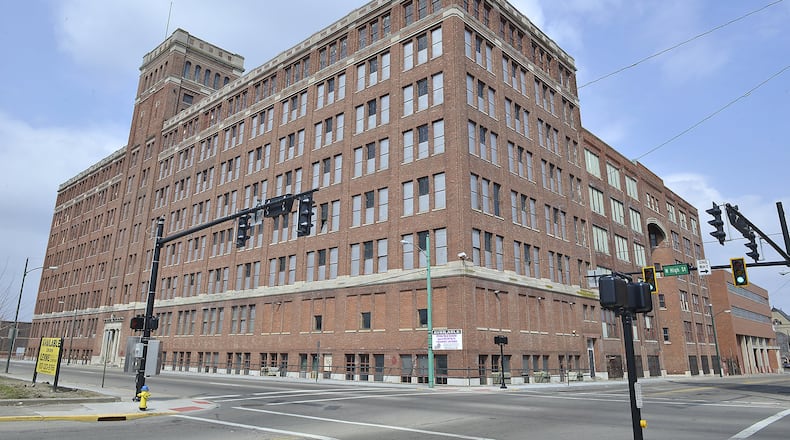Unmatched coverage
The Springfield News-Sun has written extensively on the Crowell-Collier Building since a massive fire engulfed the structure in May 2011.
By the numbers
$1.5 million: Cost for Mosier Industrial Services to purchase the Crowell-Collier Building in August 2011.
$5 million: Sale price listed for the property in November of 2012.
900,000: Amount of square feet inside the massive structure at 200 W. High St.
The owner of the Crowell-Collier building — the single largest structure in Springfield — could face financial penalties if it again fails to meet court-ordered deadlines for cleaning out the massive property at 200 W. High St.
Mosier Industrial Services, which purchased the building from longtime owner Harry Denune in 2011 for $1.5 million, has until June to remove all contents from the building, according to an agreement with the city filed on March 13 in Clark County Common Pleas Court.
The company could pay the city up to $800 per day if tasks aren’t completed on time, according to court documents.
“We think we’ve been reasonable and cooperative,” said Jerry Strozdas, the city’s law director. “Frankly, we’re disappointed they didn’t get these things done when they said they were going to in January. The bigger issue is where do we go from here and this tries to lay that groundwork for the next steps that have to be done.”
The extended deadlines were needed given the “monumental task” of removing the “enormous quantities” of items stored in the building by its previous owner, said lawyer Joe Reidy, who represents Mosier. The company has made significant progress, he said, given the time it has owned the facility.
“It was something we were happy with,” Reidy said.
The city filed a complaint against Mosier in July 2012 to set a timeline to clean out the 900,000-square-foot property due to safety concerns.
Last July, judge Richard O’Neill gave Mosier until Jan. 31, 2014, to clean the building out and make other improvements, such as removing asbestos and removing electrical circuits.
Both Mosier and the city filed motions saying those deadlines weren’t met and O’Neill found the company in contempt of court.
The company now has until April 30 to come up with a plan for fixing damaged roofs on two parts of the complex, according to the documents.
Asbestos must be removed by July 31, while certain electrical and plumbing requirements must be met by Aug. 31. One part of the complex called Building F must be demolished by Oct. 31.
O’Neill ordered three years ago that the building must be brought up to code by former owner Harry Denune and that it must be emptied of its contents by August 2012. The deadlines passed and Denune later sold the building to Mosier in September 2012.
The building — once the printing home of the world’s largest magazine publishing company — closed as a publishing plant in 1956, then was sold to Denune in 1972. He used the building to house his Dixie Distributing Co. motorcycle parts business.
The city gave Mosier some time to get its feet on the ground after the building’s purchase, Strozdas said, but filed suit after it became frustrated by a lack of progress.
The city has various powers it can use that depend on the seriousness of the situation concerning public safety, Strozdas said.
“When we get the feeling there is a danger to the public, we will act immediately as we have in the past,” he said. “This order gives us the authority to come back and ask for more in court if need be.”
A recent tour by city officials showed no immediate dangers to the public, Strozdas said, but the building remains a public nuisance. It now has a working fire system with an alarm, he said.
“The fire danger is reduced and the volume of materials in the building is greatly reduced, but there’s still a fire danger that’s there,” Strozdas said.
The building caught on fire in both 1999 and 2011. Last summer, a trailer containing scrap material caught fire inside the building’s rail yard, but was quickly contained by the Springfield Fire/Rescue Division.
As of February 2011, the building had 47 fire code violations and 38 property maintenance code violations, many of which still stand in some form or another, according to Springfield Fire Chief Nick Heimlich. The building is being treated differently because it’s not being operated as a business and has restricted access, Heimlich said.
“It’s more akin to a building under construction,” he said.
In recent years, several developments have occurred around the complex, including the National Trail Parks and Recreation District Chiller downtown ice arena. United Senior Services also recently purchased the nearby Eagles property, which it plans to redevelop.
Both the $250 million Springfield Regional Medical Center and the Ohio Valley Surgical Hospital have also been developed near the former publishing plant.
“It’s a concern about things going on around there,” Strozdas said.
The building has been cited as a key piece of development efforts downtown. The site, which takes up an entire city block in downtown Springfield, was listed at $5 million by Real Estate II in November 2012.
Reidy, who works for Frost, Brown and Todd of Columbus, said Mosier is interested in working with possible buyers on either portions or all of the property. It has “incredible promise” for redevelopment and is adaptable for several different uses, including office, residential or retail.
“There’s really no limitation on what these buildings could be used for,” Reidy said.
About the Author

